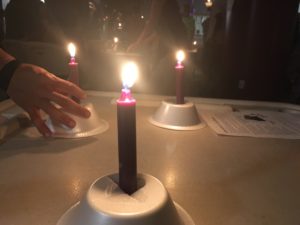
Community members lit candles Aug. 30 in memory of those who have died of heroin overdose in the Bronx.
MOTT HAVEN–Walking through the streets of the South Bronx one afternoon in July, Tino Fuentes, 53, said he sensed trouble across the street.
“You get this little gut feeling like something’s not right,” Fuentes said.
He found a man on the ground, unresponsive, drawing faint, shallow breaths. Bystanders said the man had been unconscious for several minutes, and his breathing was getting weaker as time passed. Amidst the chaos, a woman leaned over and whispered, “He did a bag.”
Fuentes, who knew she meant the man was likely overdosing on heroin, said he sprung into well-rehearsed action. An ambulance had already been called, but in the case of an overdose, every second matters. An injection of the drug Naloxone can reverse the effect of opioid overdose, but the success rate depends on rapid response.
Fuentes had a Naloxone kit across the street. After retrieving it, he removed the orange top of the vile, filled the syringe with its contents, and plunged the two-inch needle into the sinewy part of the man’s shoulder. Fuentes said he was rolling the man over to begin rescue breathing when he came to — brought back by the medication Fuentes injected.
“It’s such a selfish feeling, but I feel great. I just saved someone’s life,” Fuentes recalled.
Fuentes claims to have saved more than 75 lives with Naloxone since 2006, though he said he has lost count. He is not an EMT or doctor. He just makes sure he always has a kit on him when he is walking around New York.
“I do this because I came from these streets,” Fuentes said. “I gotta find a way to give back, you know?”
Fuentes serves as the co-director of the Syringe Exchange Program at St. Ann’s Corner of Harm Reduction in the South Bronx, where he also trains other people to administer Naloxone. Under New York State law, anyone can carry the medication after undergoing the twenty-minute training and earning a blanket-prescription.
“There is really no reason not to get trained,” Fuentes said. “We’re reaching out to try to train everybody.”
Between 2014 and 2015, Mott Haven and Hunts Point had the highest rate of heroin overdose in New York City by a significant margin. The death rates have steadily increased in recent years. Joyce Rivera, founder and executive director at St. Ann’s, said socioeconomic status and race cause people to ignore this public health crisis in the Bronx.
“The only people who really pay the price for using drugs are poor, working class people,” Rivera said to a crowd on National Overdose Awareness Day at the end of August. But she said harm reduction programs and Naloxone are saving lives in marginalized communities. “Every life matters. Who’s life is expendable?”
Across the country, heroin is becoming increasingly deadly. New reports confirm that heroin is now commonly cut with prescription Fentanyl, a drug 100 times stronger than morphine, causing users to underestimate the potency of what they inject.
“[Dealers] put whatever they put in heroin to stretch it out, to make more money,” Fuentes said. “Not too many people know what’s being put in there.”
According to Fuentes, the man he saved in July was a frequent user, injecting up to five bags a day. The day he nearly died, he was only on his first bag, which he had sniffed rather than injected. Since those are not the conditions that generally lead to overdose, Fuentes said he suspects Fentanyl was present in the mixture. Naloxone is still effective against Fentanyl-laced heroin though experts say in those cases it might take more than one dose to revive the person.
Since the Naloxone program began at St. Ann’s in 2006, awareness around heroin overdose has increased dramatically in New York. Now, all police officers in Mott Haven carry Naloxone. Overdose response trainings are being held in local prisons. Laws around prescription to carry have changed to give easier access to the life-saving medication.
Organizers at St. Ann’s say the shift in awareness and action was influenced by the changing demographics of heroin use and abuse throughout New York State. In 2013, more white New Yorkers than black or Hispanic New Yorkers died of overdose statewide.
“The progress we have made, the general tipping point we have passed, has to do with all of the white people who have overdosed,” said Bill Matthews, clinical director at St. Ann’s.
For Fuentes, it’s frustrating to believe nobody cares about the Bronx. But he said the most important thing is that progress is finally being made, and it’s helping people and saving lives.
“This is hurting everybody,” Fuentes said.

